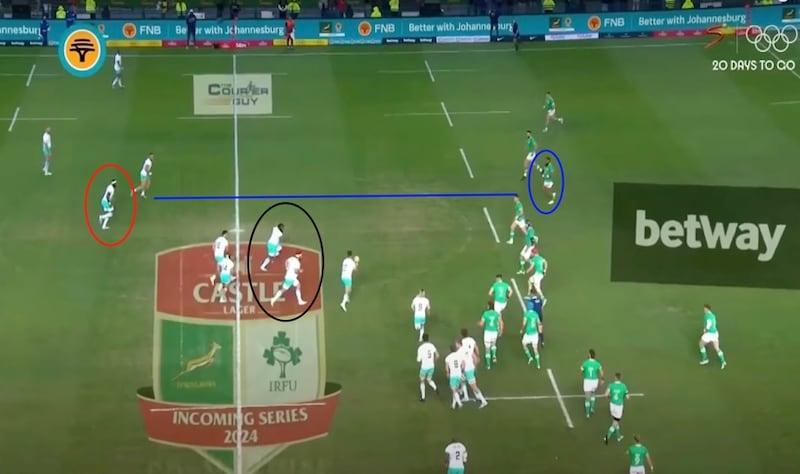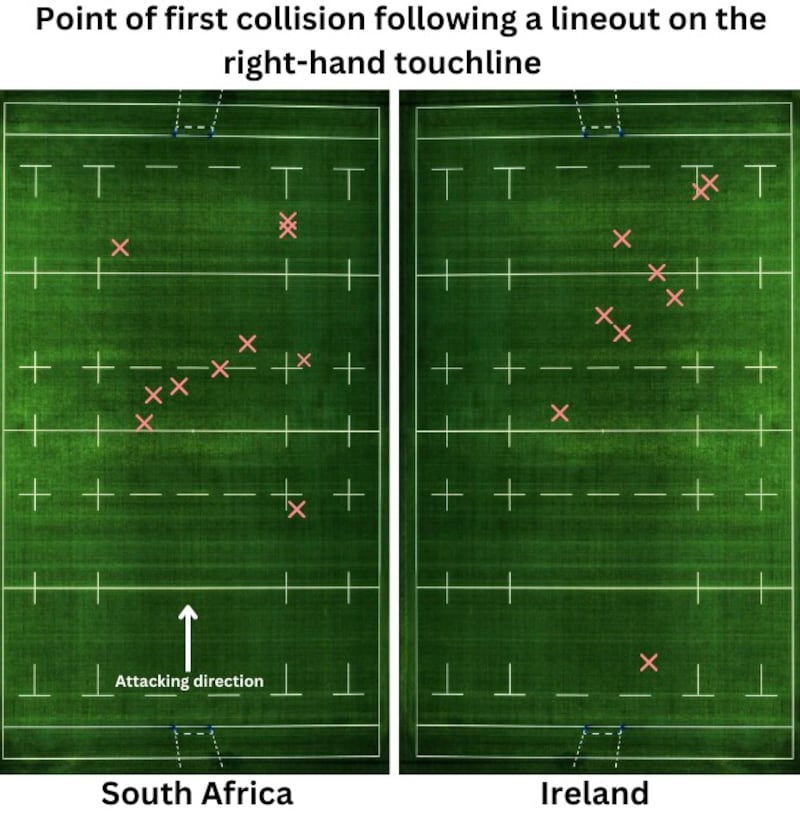Just under 15 minutes into Ireland’s series-opening defeat to South Africa, Siya Kolisi’s thunderous carry into Robbie Henshaw sent shock waves throughout the rugby fraternity.
Physically, the hit almost knocked the Irish centre out of the game. The force involved saw Henshaw’s smart mouthguard to call for a head-injury assessment.
Away from player safety, though, the build-up to the shuddering collision demonstrated the next stage of South Africa’s now customary post-World Cup regeneration. Here was a burly Springbok forward carrying, not into the heart of the defence, but in a wide position off a well constructed move. If South Africa can develop a more expansive attack to go with their destructive set piece and blitz defence good luck to everyone else.
Had referee Luke Pearce not stopped the game due to the frightening nature of the collision, South Africa were in an ideal position. Such is the devastating effect of a positive carry against a lone defender out wide.
South Africa manufactured these situations time and again last week. Ireland, by contrast, went against their usual wide identity, finding themselves running into ‘Bok walls close to set pieces and the breakdown. This was a reversal of how either side historically wants to play. Among the many improvements sought by Andy Farrell this week, Ireland’s attacking width will be a significant one to watch.
In the memorable carry which acts as a microcosm of South Africa’s approach under new attack coach Tony Brown, Kolisi took the ball on first phase off an attacking lineout. The Springboks positioned their captain in an unusually wide position barely 20m away from the touchline opposite the lineout.
Brown is a fervent worshipper at the altar of the four-man lineout. With three forwards in the backline instead of the set piece, two outside the outhalf, one – in this case Kolisi – slightly wider, Brown’s attack has options aplenty which must be respected by the defence.

The requirement of marking the opposition decoys left Henshaw on his own. Instead of carrying in a narrow channel into a combination of an outhalf, centre and backrow forward, Kolisi was one-on-one with the Irish centre. Henshaw is a strong defender, but he came off second best against a man who had a 60 per cent dominant carry rate at last year’s World Cup.
Under Brown, the mastermind of the Japan attack which cut Ireland open at the 2019 World Cup, the Springboks have immediately become a side which loves to go wide. Not as much as their more traditional up the jumper approach, but enough to add another threat to their arsenal.
Against Ireland, South Africa moved the ball 20m from the previous ruck 16 per cent of the time, the most of all eight major international teams in action on Saturday. Ireland didn’t feature in the top five. By contrast, during the last World Cup South Africa moved the ball wider than the first receiver the least of any other team in the competition (17 per cent).
Ireland were the widest team in the 2024 Six Nations. They topped the list for moving the ball 10m away from the previous ruck (53 per cent), beyond the first receiver (35 per cent) and wider than the second receiver (15 per cent).
Despite Kurt-Lee Arendse’s opening try coming from side-to-side openfield play, set pieces were arguably where the attacking discrepancy between the two sides was at its most glaring. A basic plot of where both teams met the defence off the lineout, either an attempted tackle or maul, paints a stark picture.

The old adage dictates that you have to earn the right to go wide by softening up the middle of the defence first. South Africa did so, using centre Jesse Kriel to punch a hole off their first two lineouts. Kriel led both sides with 77m carried on the day. The third lineout brought the Kolisi-Henshaw collision. This time Kriel was a decoy as the ‘Boks went to their wider variation.
Ireland couldn’t find that initial narrow punch. All too often they tried the different elements of their playbook close to the lineout. Inside balls to blindside wingers Calvin Nash and James Lowe have worked against other teams, but running hard angles into the teeth of a South African pack requires perfect running lines. One attack aside, the set play for Conor Murray’s try, Ireland lacked this precision.
When these sides met at the World Cup, Bundee Aki’s ability to soften the middle of South Africa’s defence was stellar – to the tune of 66m made and four defenders beaten. On Saturday those figures were four and zero respectively. This time around the ‘Boks were ready for his carries down the 12 channel.
When Ireland couldn’t punch those narrow holes there was no clear plan B. Time and again different plays involving initial carries close to the set piece were utilised. South Africa, by contrast, went early and often to strong runners in good positions in the wide channels.
Aki is injured this week, necessitating the return of Garry Ringrose as Henshaw shifts across to inside centre. Ireland certainly lose some power with the Leinster centre playing at the expense of his Connacht counterpart, but they also gain a stellar distributor who, at the last World Cup, showed an ability to carry into the heart of the blitz defence and exploit the space it leaves out wide. Across that whole tournament, according to analyst Simon Chi, Ringrose was the competition’s best passing centre. All told, his ability to put team-mates into space was worth just over 25 expected points added for Ireland, more than double the second ranked centre in that category.
Balance is required. Henshaw, Caelan Doris et al will still be asked to carry hard into the belly of the world’s strongest defence. Yet having watched the success of South Africa’s newfound width, Ireland have both the template and personnel to return to an attacking strategy which should already be a part of their identity – move the big boys around the park.
Should they do so successfully, with both sides attacking fluently, the spectator will be a big winner on Saturday. Who prevails on the scoreboard, though, will at least be in part decided by this battle of attacking strategies.
- Sign up for push alerts and have the best news, analysis and comment delivered directly to your phone
- Join The Irish Times on WhatsApp and stay up to date
- Listen to our Inside Politics podcast for the best political chat and analysis















